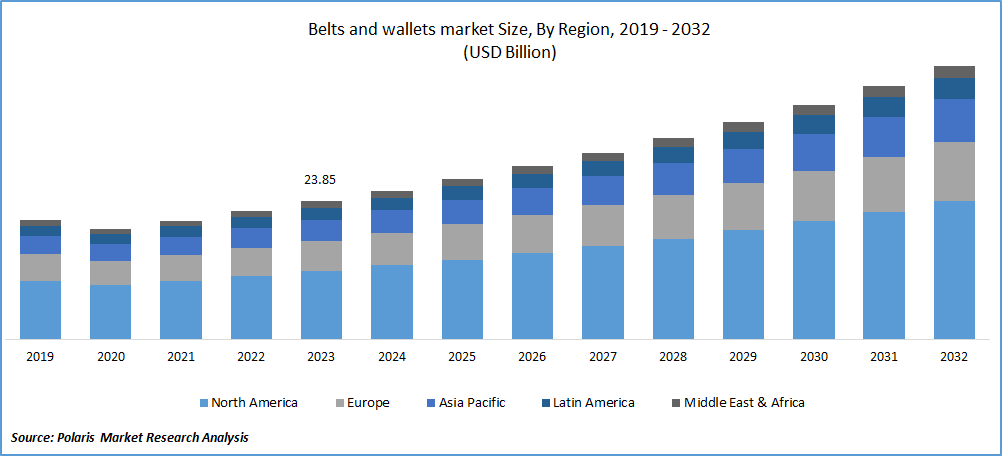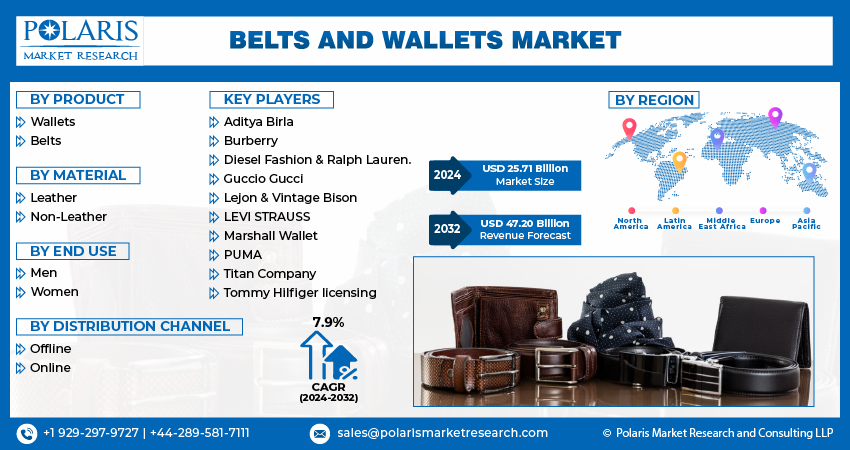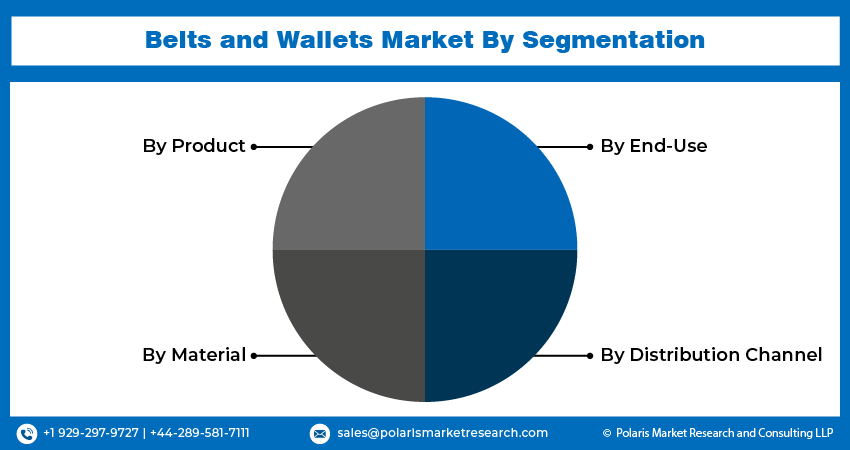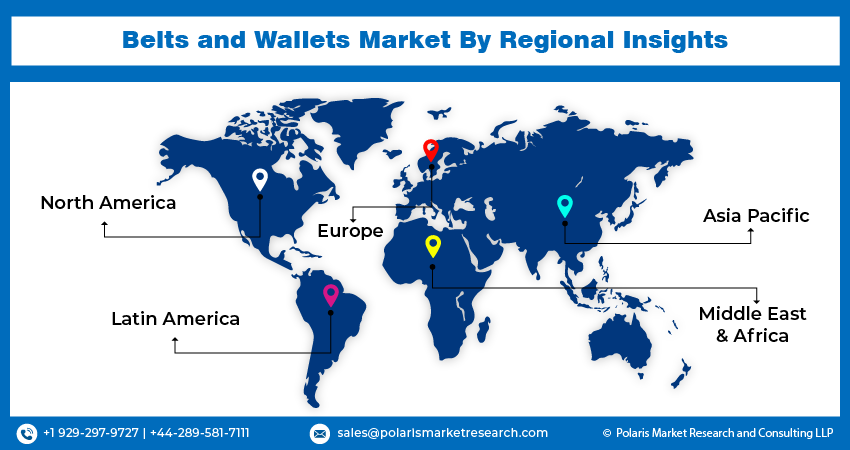
Belts and Wallets Market Share, Size, Trends, Industry Analysis Report, By Product (Wallets, Belts); By Material; By End Use; By Distribution Channel; By Region; Segment Forecast, 2023 - 2032
- Published Date:Mar-2024
- Pages: 119
- Format: PDF
- Report ID: PM4739
- Base Year: 2023
- Historical Data: 2019-2022
Report Outlook
Market Outlook
The belts and wallets market size were valued at USD 23.85 billion in 2023. The market is anticipated to grow from USD 25.71 billion in 2024 to USD 47.20 billion by 2032, exhibiting a CAGR of 7.9% during the forecast period.
Industry Trend
The expanding fashion trend and the increasing utilization of wallets and belts among corporate populations globally primarily propel the market. The significance of belts and wallets as fashion accessories has grown, particularly among millennials. Furthermore, there is an anticipation that the rising demand among the younger generation for leather-made belts and wallets will present abundant opportunities for market expansion throughout the forecast period.

To Understand More About this Research:Request a Free Sample Report
The surge in demand for leather products such as wallets and belts may yield lucrative prospects for companies operating in the sustainable sector. Leather wallets and pouches are commonly employed for daily activities due to the consumer's preference for highly durable and stylish leather goods. Additionally, leather maintains its smoothness and durability even when folded, providing greater comfort when carried in the pocket compared to materials like plastic or nylon, which can be rigid and uncomfortable.
Moreover, the COVID-19 pandemic has negatively impacted offline sales of wallets and belts in various affected countries, including China and India, due to social isolation measures and lockdown mandates. Furthermore, the persistent nature of the pandemic has prompted individuals to adopt better financial management practices and curb excessive spending. Consequently, consumers have become more hesitant to make purchases amid concerns over virus transmission, even after the lifting of lockdowns. Therefore, the pandemic has hurt the belts and wallets market.
For companies launching new products, navigating the landscape involves a multifaceted approach encompassing market analysis, strategic planning, and execution. Firstly, understanding market dynamics through comprehensive research is paramount. This includes assessing consumer preferences, competitive offerings, and industry trends to identify opportunities and potential challenges. Strategic planning involves developing a clear product concept, defining target markets, and establishing competitive positioning. It also entails setting realistic goals and timelines, allocating resources effectively, and developing a compelling value proposition.
Execution involves product development, branding, marketing, and distribution. This includes designing and manufacturing the product to meet consumer needs, creating a strong brand identity, implementing targeted marketing campaigns, and establishing distribution channels to reach the target audience efficiently.
- For Instance, In September 2022, ThruDark unveiled its inaugural collection entirely manufactured in Great Britain, featuring a selection of leather goods crafted by artisans and sourced from UK tanneries.
The belts and wallets market is anticipated to grow during the forecast period, the market is propelled by the increasing demand for fashionable wallets and belts among the populace. Furthermore, the advancing technology of RFID-based wallets and the proactive initiatives taken by key market players are poised to create lucrative growth opportunities within the market throughout the forecast period.

Key Takeaway
- Asia Pacific dominated the largest market and contributed to more than 40% of the share in 2023.
- North America accounted for the market to be the fastest growing CAGR during the forecast period.
- By Material category, the Leather segment accounted for the largest market share in 2023.
- By End-use industry category, the Men's segment is projected to grow at a high CAGR during the projected period.
What are the market drivers driving the demand for the belts and wallets market?
- The increasing consumer interest in leather accessories is projected to spur product demand.
Fashion accessories like belts and wallets are more than just style statements; they fulfill both practical and aesthetic needs for consumers. The durability of leather fashion accessories is widely acknowledged, often surpassing the longevity of clothing and non-leather alternatives. This durability is especially apparent in exclusive product categories that have seen a surge in popularity in recent years. As a result, there's a growing demand for leather accessories such as wallets, belts, and other items.
The expanding fashion industry plays a pivotal role in driving this demand. With ever-evolving trends and consumer preferences, there's a notable increase in the desire for leather wallets among individuals. This surge in demand not only reflects the enduring appeal of leather accessories but also contributes to the overall growth of the market. As consumers seek high-quality, long-lasting accessories to complement their style, the leather fashion accessory segment continues to thrive.
The rise of e-commerce and online shopping has greatly impacted the fashion industry. Online shopping has made it easier for consumers to purchase accessories from a wider range of brands and retailers. The use of innovative materials and production techniques can influence the design and functionality of the belts and wallets. For example, the use of sustainable materials and production methods can appeal to environmentally conscious consumers.
Which factor is restraining the demand for belts and wallets?
- Fluctuations in disposable income levels are likely to impede market growth
The belts and wallets market faces various constraints that impact its dynamics and growth potential. Economic factors such as fluctuations in disposable income levels and consumer spending patterns can significantly influence demand for these accessories. During periods of economic uncertainty or recession, consumers may prioritize essential purchases over discretionary items like fashion accessories, leading to reduced sales. Additionally, changing fashion trends and preferences pose a challenge for market players, as they must continuously innovate and adapt their product offerings to remain competitive. Moreover, environmental and ethical concerns surrounding the sourcing of materials, particularly leather, can impact consumer perception and purchasing decisions. Companies operating in this market must navigate these constraints by staying attuned to economic fluctuations, staying ahead of fashion trends, addressing sustainability concerns, and offering value-added features to differentiate their products. Overall, understanding and effectively addressing these constraints are essential for sustained success in the belts and wallets market.
Report Segmentation
The market is primarily segmented based on product, material, end-user, distribution channel and region.
|
By Product |
By Material |
By End Use |
By Distribution Channel |
By Region |
|
|
|
|
|
To Understand the Scope of this Report:Speak to Analyst
Category Wise Insights
By Material Insights
Based on the Material analysis, the market is segmented into leather and non-leather. The leather segment accounted for the largest market in 2023. Consumers are increasingly seeking high-quality products that are long-lasting and can withstand wear and tear. Leather is known for its durability, which makes it an ideal material for belts and wallets. As consumers look for products that are both stylish and practical, the demand for leather belts and wallets is likely to increase. As the global economy continues to grow, more people are entering the middle class and can afford luxury goods such as leather belts and wallets. The expanding luxury market is expected to drive demand for high-end leather products.
By End Use Insights
Based on End-use industry analysis, the market has been segmented on the basis of men's and women’s. Men segment dominated the market in 2022. Men’s segment is expected to be the fastest growing CAGR during the forecast period. Men are becoming more fashion-conscious and are paying more attention to their appearance. Belts and wallets are important accessories that help men to create a fashionable look. As fashion trends continue to change, the demand for new styles and designs of belts and wallets is likely to increase. Men are becoming increasingly aware of the importance of accessories in creating a complete look. Belts and wallets are important accessories that can elevate an outfit and give men a stylish look.

Regional Insights
Asia Pacific
Asia Pacific region is accounted to be the largest market in 2023. Asia Pacific region emerged as the largest market for fashion and luxury goods. This dominance can be attributed to several key factors. The region is experiencing a significant expansion of its middle-class population, particularly in countries such as China and India. This growing middle class is accompanied by an increase in disposable income levels, allowing consumers to allocate more spending towards non-essential items like fashion accessories.
Additionally, there has been a notable rise in consumer awareness about fashion and luxury goods across the region. As lifestyles evolve and urbanization continues, consumers are becoming more discerning and willing to invest in premium products that reflect their style and status. Countries like China and India, with their large and increasingly affluent consumer bases, are driving much of this growth. Consequently, the Asia Pacific region has become a focal point for fashion and luxury brands looking to capitalize on these emerging opportunities.
North America
North America boasts a mature and affluent consumer market with a strong purchasing power, making it an attractive region for fashion and accessory brands. Additionally, there is a growing trend towards premiumization and the adoption of luxury goods among North American consumers, driving demand for high-quality belts and wallets. Moreover, the region's fashion-conscious population, coupled with a preference for trendy accessories, further fuels market growth. Furthermore, the increasing prevalence of online retail platforms and e-commerce channels facilitates easy access to a wide range of products, contributing to market expansion. Additionally, innovative product designs and features, coupled with effective marketing strategies, are expected to stimulate consumer interest and drive sales in the North American belts and wallets market. Overall, these factors combined are expected to propel North America to achieve the fastest CAGR in the belts and wallets segment during the forecast period.

Competitive Insight
The belts and wallets market demonstrates fragmentation, with competition arising from a diverse array of players. Major service providers within this sector continually upgrade their technologies to sustain a competitive advantage, placing a strong emphasis on efficiency, reliability, and safety. In pursuit of significant market presence, these entities prioritize strategic partnerships, ongoing product improvements, and collaborative initiatives to outperform industry peers. This commitment to innovation and collaboration underscores their dedication to meeting evolving consumer demands and staying ahead in a dynamic and competitive market landscape.
Some of the major players operating in the global market include
- Aditya Birla
- Burberry
- Diesel Fashion & Ralph Lauren.
- Guccio Gucci
- Lejon & Vintage Bison
- LEVI STRAUSS
- Marshall Wallet
- PUMA
- Titan Company
- Tommy Hilfiger licensing
Recent Developments
- In July 2023, Lejon & Vintage Bison is widely recognized for its dedication to innovation and state-of-the-art technology. That's why they are delighted to announce their partnership with Nexbelt. This collaboration enables to craft premium-quality ratchet belts that embody their belief in the superiority of all belt styles.
Report Coverage
The belts and wallets market report emphasizes key regions across the globe to provide a better understanding of the product to the users. Also, the report provides market insights into recent developments, and trends and analyzes the technologies that are gaining traction around the globe. Furthermore, the report covers an in-depth qualitative analysis of various paradigm shifts associated with the transformation of these solutions.
The report provides a detailed analysis of the market while focusing on various key aspects such as competitive analysis, component, package type, power range, wavelength, wavelength, and futuristic growth opportunities.
Belts and Wallets Market Report Scope
|
Report Attributes |
Details |
|
Market size value in 2024 |
USD 25.71 billion |
|
Revenue Forecast in 2032 |
USD 47.20 billion |
|
CAGR |
7.9% from 2024 - 2032 |
|
Base year |
2023 |
|
Historical data |
2019 – 2022 |
|
Forecast period |
2024 - 2032 |
|
Quantitative units |
Revenue in USD million/billion and CAGR from 2023 to 2032 |
|
Segments covered |
By Product, By Material, By End User, By Distribution Channel, By Region |
|
Regional scope |
North America, Europe, Asia Pacific, Latin America; Middle East & Africa |
|
Customization |
Report customization as per your requirements with respect to countries, region and segmentation. |
FAQ's
Belts and Wallets Market report covering key segments are product, material, end-user, distribution channel and region.
Belts and Wallets Market Size Worth $ 47.20 Billion By 2032
The belts and wallets market exhibiting a CAGR of 7.9% during the forecast period.
Asia Pacific is leading the global market
The key driving factors in Belts and Wallets Market are the increasing consumer interest in leather accessories is projected to spur product demand
